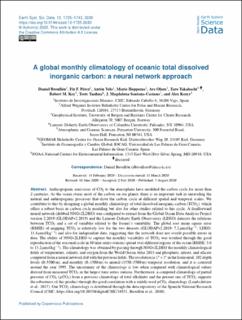| dc.contributor.author | Broullón, Daniel | |
| dc.contributor.author | Velo, Antón | |
| dc.contributor.author | Hoppema, Mario | |
| dc.contributor.author | Olsen, Are | |
| dc.contributor.author | Takahashi, Taro | |
| dc.contributor.author | Key, Robert M. | |
| dc.contributor.author | Tanhua, Toste | |
| dc.contributor.author | Santana-Casiano, J. Magdalena | |
| dc.contributor.author | Kozyr, Alex | |
| dc.contributor.author | Perez, Fiz F. | |
| dc.date.accessioned | 2021-02-25T12:43:02Z | |
| dc.date.available | 2021-02-25T12:43:02Z | |
| dc.date.created | 2021-01-18T09:56:50Z | |
| dc.date.issued | 2020 | |
| dc.Published | Earth System Science Data. 2020, 12 1725-1743. | |
| dc.identifier.issn | 1866-3508 | |
| dc.identifier.uri | https://hdl.handle.net/11250/2730429 | |
| dc.description.abstract | Anthropogenic emissions of CO2 to the atmosphere have modified the carbon cycle for more than 2 centuries. As the ocean stores most of the carbon on our planet, there is an important task in unraveling the natural and anthropogenic processes that drive the carbon cycle at different spatial and temporal scales. We contribute to this by designing a global monthly climatology of total dissolved inorganic carbon (TCO2), which offers a robust basis in carbon cycle modeling but also for other studies related to this cycle. A feedforward neural network (dubbed NNGv2LDEO) was configured to extract from the Global Ocean Data Analysis Project version 2.2019 (GLODAPv2.2019) and the Lamont–Doherty Earth Observatory (LDEO) datasets the relations between TCO2 and a set of variables related to the former's variability. The global root mean square error (RMSE) of mapping TCO2 is relatively low for the two datasets (GLODAPv2.2019: 7.2 µmol kg−1; LDEO: 11.4 µmol kg−1) and also for independent data, suggesting that the network does not overfit possible errors in data. The ability of NNGv2LDEO to capture the monthly variability of TCO2 was testified through the good reproduction of the seasonal cycle in 10 time series stations spread over different regions of the ocean (RMSE: 3.6 to 13.2 µmol kg−1). The climatology was obtained by passing through NNGv2LDEO the monthly climatological fields of temperature, salinity, and oxygen from the World Ocean Atlas 2013 and phosphate, nitrate, and silicate computed from a neural network fed with the previous fields. The resolution is 1∘×1∘ in the horizontal, 102 depth levels (0–5500 m), and monthly (0–1500 m) to annual (1550–5500 m) temporal resolution, and it is centered around the year 1995. The uncertainty of the climatology is low when compared with climatological values derived from measured TCO2 in the largest time series stations. Furthermore, a computed climatology of partial pressure of CO2 (pCO2) from a previous climatology of total alkalinity and the present one of TCO2 supports the robustness of this product through the good correlation with a widely used pCO2 climatology (Landschützer et al., 2017). Our TCO2 climatology is distributed through the data repository of the Spanish National Research Council (CSIC; https://doi.org/10.20350/digitalCSIC/10551, Broullón et al., 2020). | en_US |
| dc.language.iso | eng | en_US |
| dc.publisher | Copernicus Publications | en_US |
| dc.rights | Navngivelse 4.0 Internasjonal | * |
| dc.rights.uri | http://creativecommons.org/licenses/by/4.0/deed.no | * |
| dc.title | A global monthly climatology of oceanic total dissolved inorganic carbon: a neural network approach | en_US |
| dc.type | Journal article | en_US |
| dc.type | Peer reviewed | en_US |
| dc.description.version | publishedVersion | en_US |
| dc.rights.holder | Copyright Author(s) 2020. | en_US |
| cristin.ispublished | true | |
| cristin.fulltext | original | |
| cristin.qualitycode | 1 | |
| dc.identifier.doi | 10.5194/essd-12-1725-2020 | |
| dc.identifier.cristin | 1872878 | |
| dc.source.journal | Earth System Science Data | en_US |
| dc.source.40 | 12 | |
| dc.source.pagenumber | 1725–1743 | en_US |
| dc.identifier.citation | Earth System Science Data. 2020, 12 (3), 1725–1743. | en_US |
| dc.source.volume | 12 | en_US |
| dc.source.issue | 3 | en_US |

